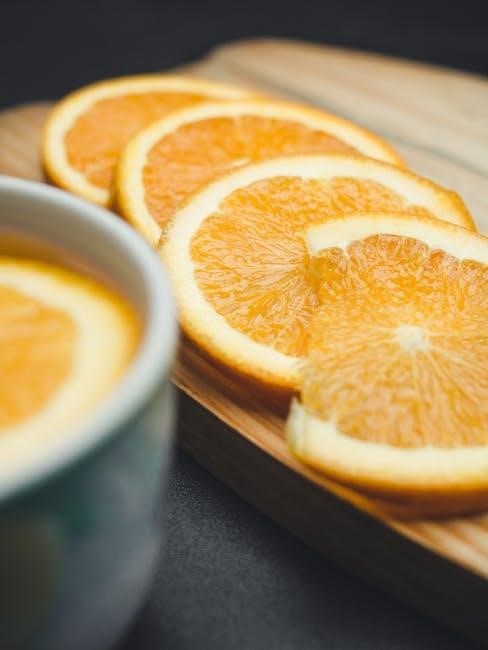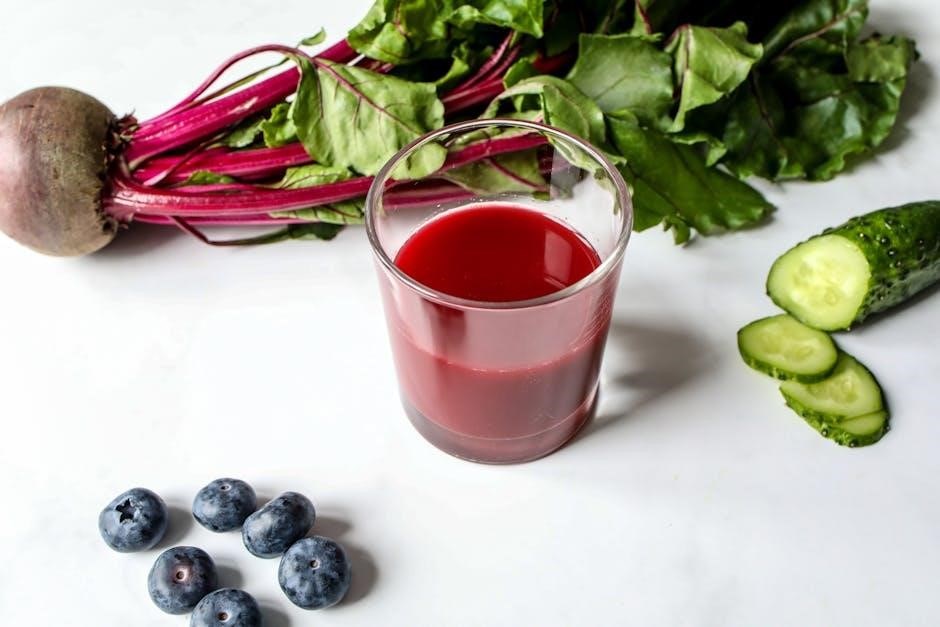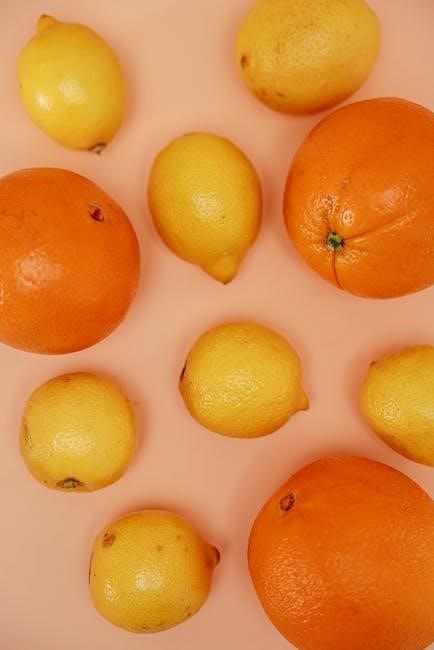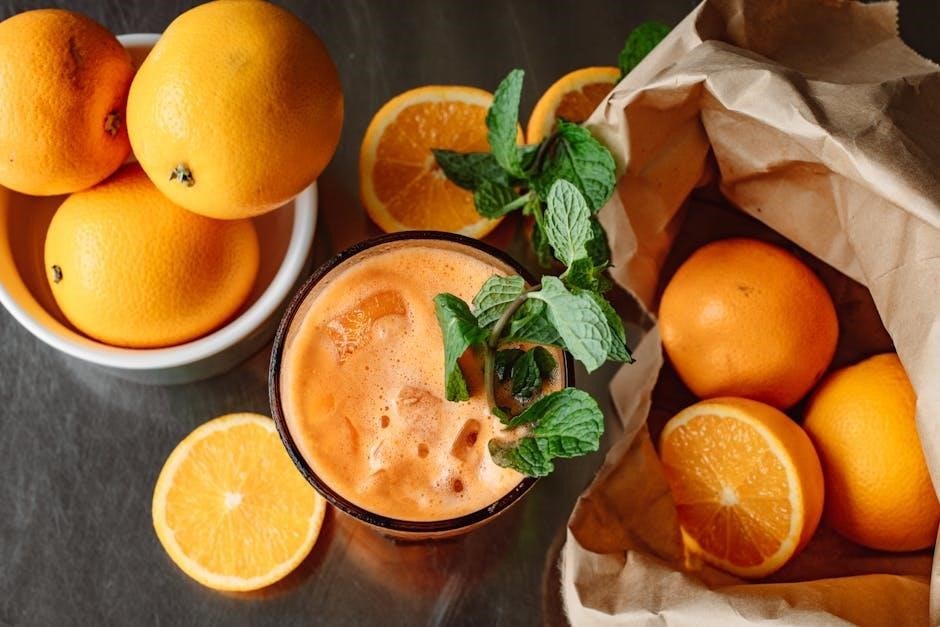juicing for beginners pdf
Juicing is an excellent way to enhance your daily nutrition by extracting fresh juice from fruits and vegetables‚ offering concentrated vitamins‚ minerals‚ and health benefits.
1.1 What is Juicing?
Juicing is the process of extracting liquid from fruits‚ vegetables‚ and herbs‚ creating a concentrated source of vitamins‚ minerals‚ and antioxidants. It allows for easy digestion and quick absorption of nutrients. Unlike blending‚ which retains fiber‚ juicing separates the liquid‚ making it ideal for those who struggle with high-fiber diets. Slow juicing‚ or cold-pressing‚ preserves nutrients by minimizing oxidation and heat. This method is recommended for beginners as it ensures high-quality juice. Juicing can boost energy‚ support weight loss‚ and enhance overall wellness. It’s also a great way to consume more fruits and vegetables in one serving than you might eat whole. By following simple recipes and guidelines‚ anyone can start juicing at home and enjoy its numerous health benefits.
1.2 Benefits of Juicing for Beginners
Juicing offers numerous benefits‚ especially for beginners‚ as it provides an easy way to increase daily nutrient intake. By extracting fresh juice from fruits and vegetables‚ you gain a concentrated source of vitamins‚ minerals‚ and antioxidants. This method is ideal for those who struggle with digesting high-fiber foods‚ as it breaks down ingredients for easier absorption. Juicing can boost energy levels‚ support weight loss‚ and enhance overall wellness. It also allows for creative combinations of flavors‚ making it enjoyable to consume a variety of fruits and vegetables. Additionally‚ juicing can improve skin health‚ aid in detoxification‚ and support immune function. With a 7-day shopping list and simple recipes‚ beginners can easily incorporate juicing into their daily routine and enjoy its health benefits.
1.3 How Juicing Differs from Blending
Juicing and blending are two popular methods of processing fruits and vegetables‚ but they differ significantly in approach and outcome. Juicing extracts the liquid from ingredients‚ leaving behind pulp and fiber‚ while blending combines the entire fruit or vegetable into a smooth‚ fiber-rich consistency. This makes juicing ideal for those who want a concentrated dose of vitamins and minerals without the bulk of fiber. Blending‚ on the other hand‚ retains all the fiber‚ providing a more filling and digestion-slowing option. Juicing is often preferred for its ease of absorption and quick energy boost‚ whereas blending supports digestive health through fiber intake. Both methods are healthy but cater to different nutritional goals and preferences‚ making them versatile choices for incorporating more fruits and vegetables into your diet.

Essential Equipment for Juicing
Invest in a quality juicer‚ such as a centrifugal or cold-press model‚ along with tools like juicing cones and a cutting board for efficient and safe juicing.

2.1 Types of Juicers: Centrifugal vs. Cold Press
When choosing a juicer‚ two popular options are centrifugal and cold press juicers. Centrifugal juicers use high-speed spinning blades to extract juice‚ making them fast and affordable. They are ideal for beginners due to their ease of use and lower cost. However‚ they can generate heat‚ which may reduce the juice’s nutritional value over time. Cold press juicers‚ also known as slow juicers‚ operate at a lower speed‚ crushing and pressing fruits and vegetables to extract juice without heat. This method preserves more nutrients and enzymes‚ resulting in higher-quality juice with less oxidation. Cold press juicers are quieter and better for leafy greens but are generally more expensive and require more time to use. Both types are effective‚ but the choice depends on your budget‚ patience‚ and juicing goals.
2.2 Must-Have Tools for Juicing
To get started with juicing‚ you’ll need a few essential tools to ensure a smooth and efficient process. First‚ a juicer is the most critical appliance‚ available in centrifugal or cold-press models. A cutting board and sharp knife are necessary for preparing fruits and vegetables. A sturdy vegetable peeler can help remove skins or rinds from citrus fruits or other produce. Strainers or fine-mesh sieves are useful for filtering pulp or sediment if desired. Glass jars or airtight containers are ideal for storing fresh juice to maintain its quality and prevent oxidation. Additionally‚ a juicing brush can help clean your juicer effectively. These tools will help you prepare‚ juice‚ and store your creations efficiently‚ ensuring the best results for your juicing journey.
2.3 Care and Maintenance of Your Juicer
Proper care and maintenance of your juicer are crucial to ensure its longevity and optimal performance. Always clean your juicer immediately after use to prevent residue and pulp from hardening‚ as this can make cleaning more difficult. Use a soft brush or sponge to wipe down parts‚ and rinse with warm water. Regularly check and replace worn-out components like juicing cones or screens to maintain efficiency. Store your juicer in a dry place to prevent rust or mold. For heavy-duty juicing‚ avoid operating the machine for more than 17 seconds at a time to prevent overheating. Refer to your juicer’s manual for specific care instructions‚ and use a dedicated juicing brush for thorough cleaning. Proper maintenance will keep your juicer functioning well and ensure delicious‚ healthy juices every time.
Best Practices for Juicing
Juicing consistently‚ listening to your body‚ and gradually experimenting with new ingredients can enhance your experience. Start simple‚ monitor how your body reacts‚ and adjust recipes accordingly. Incorporate a variety of colors to ensure a broad range of nutrients. Hydrate well before juicing and consider consulting a healthcare professional to tailor your juicing routine to your specific needs. This approach will help you maximize the benefits of juicing while maintaining a balanced diet and healthy lifestyle.
3.1 Preparing Ingredients for Juicing
Preparing ingredients is a crucial step in juicing. Always wash fruits and vegetables thoroughly to remove dirt‚ pesticides‚ or bacteria. Peel thick-skinned fruits like oranges or pineapples‚ as their skins can be bitter. Chop ingredients into small‚ manageable pieces to ensure your juicer processes them efficiently. Remove seeds and pits‚ as some can be harmful or add unwanted flavors. Use fresh‚ organic produce whenever possible for optimal taste and nutrition. Store ingredients properly before juicing to maintain freshness. For leafy greens‚ gently rinse and pat dry to avoid diluting the juice with excess water. This preparation ensures a smooth and enjoyable juicing experience for beginners.
3.2 Storing Juices Properly
Proper storage is essential to maintain the freshness and nutritional value of your juices. Always store juices in airtight‚ glass containers to prevent oxidation and contamination. Keep them refrigerated at a temperature below 4°C (39°F) to slow down spoilage. Freshly made juices are best consumed within 24 hours‚ as vitamins and enzymes degrade over time. Avoid storing juices in metal or plastic containers‚ as they can react with the acidity of the juice. For optimal freshness‚ store juices away from direct light and heat. If you won’t be drinking the juice immediately‚ consider labeling the container with the date and time. Some juices‚ like those with leafy greens‚ may not store well‚ so drink them right away. Proper storage ensures your juices remain nutritious and flavorful.
3.3 Common Mistakes to Avoid

When starting with juicing‚ there are several common mistakes to be aware of. One of the most frequent errors is overloading on sugary fruits‚ which can lead to excessive sugar intake. Another mistake is not balancing flavors‚ resulting in juices that taste too bitter or unpleasant. Many beginners also forget to wash their fruits and vegetables thoroughly‚ which can introduce harmful pesticides or bacteria. Additionally‚ using low-quality juicers or improper techniques can reduce the juice’s nutritional value. Over-relying on juicing without incorporating a balanced diet is another pitfall‚ as juicing should complement‚ not replace‚ whole foods. Lastly‚ ignoring allergies or sensitivities to certain ingredients can cause adverse reactions. By avoiding these mistakes‚ beginners can enjoy a safer and more rewarding juicing experience;
Popular Juicing Recipes for Beginners
Discover simple and delicious juicing recipes perfect for beginners. Explore healthy‚ flavorful options that boost your energy and satisfy your taste buds with ease and variety every day.

4.1 Simple and Delicious Basic Recipes
Start your juicing journey with easy‚ mouthwatering recipes that combine fresh fruits and vegetables. These basic blends are perfect for beginners‚ offering simplicity and nutrition without overwhelming flavors. One classic option is the “Sunrise Starter‚” made with 2 oranges‚ 1 apple‚ and a hint of ginger for a refreshing morning drink. Another favorite is the “Green Glow‚” blending 2 cucumbers‚ 1 green apple‚ and a handful of spinach for a light‚ detoxifying juice. For a sweeter treat‚ try the “Berry Boost‚” mixing 1 cup of mixed berries‚ 1 pear‚ and a splash of lemon juice for natural energy. These recipes are easy to prepare‚ require minimal ingredients‚ and are gentle on the palate‚ making them ideal for those new to juicing. Experiment with these basics and gradually explore more complex flavors as you gain confidence.
4.2 Green Juice Recipes for Health
Green juices are a powerhouse of nutrients‚ perfect for boosting energy and promoting overall well-being. A great starter recipe is the “Green Energy” blend‚ combining 2 cups of spinach‚ 1 cup of kale‚ 1 green apple‚ and a squeeze of fresh lemon juice for a refreshing and healthy drink. Another option is the “Detox Delight‚” made with 2 cucumbers‚ 1 celery stalk‚ 1 handful of parsley‚ and a lime wedge for a cleansing effect. For a sweeter green juice‚ try the “Emerald Elixir‚” blending 1 pear‚ 2 handfuls of spinach‚ and a slice of ginger for a smooth and invigorating taste. These recipes are packed with vitamins‚ minerals‚ and antioxidants‚ making them ideal for supporting immunity‚ digestion‚ and vitality. Start with mild flavors and gradually incorporate more greens as your palate adjusts.
4.3 Fruit-Based Juices for Taste
Fruit-based juices are a delicious way to enjoy the natural sweetness of fresh produce while reaping its nutritional benefits. A simple yet flavorful recipe is the “Berry Bliss‚” made by juicing 1 cup of strawberries‚ 1 cup of blueberries‚ and 1/2 cup of pineapple. Another tasty option is the “Citrus Burst‚” combining 2 oranges‚ 1 grapefruit‚ and a splash of lemon for a refreshing and tangy drink. For tropical vibes‚ try the “Mango Peach Delight‚” blending 1 ripe mango‚ 1 peach‚ and a handful of mint leaves. These fruit-based juices are perfect for satisfying sweet cravings and introducing beginners to the world of juicing. Experiment with seasonal fruits to create vibrant and mouthwatering combinations that are both healthy and enjoyable!
4.4 Juice Recipes for Weight Loss
Juicing can be a great addition to a weight loss plan when done correctly. Focus on recipes that are low in sugar but high in nutrients and fiber. The “Green Goddess” juice is a popular choice‚ combining 2 cups of spinach‚ 1 cucumber‚ 1 celery stalk‚ 1 small apple‚ and 1/2 lemon. This blend is rich in vitamins and antioxidants while being low in calories. Another option is the “Citrus Refresher‚” made with 1 grapefruit‚ 1 orange‚ and a slice of ginger. Grapefruit is known for its metabolism-boosting properties‚ making it ideal for weight loss. For a sweeter option‚ try the “Berry Boost‚” mixing 1 cup of cranberries‚ 1/2 cup of blueberries‚ and 1/2 cucumber. These juices not only support weight loss but also provide essential nutrients for overall health. Always opt for whole‚ unpeeled fruits and vegetables to retain fiber and nutrients‚ and consider drinking juices before meals to help control hunger and portion sizes. Incorporating these recipes into a balanced diet can enhance your weight loss journey.

7-Day Juicing Shopping List
Stock up on fresh fruits‚ vegetables‚ and essentials for a week of juicing. Include leafy greens‚ cruciferous vegetables‚ citrus fruits‚ root vegetables‚ and apples or pears for natural sweetness. Don’t forget herbs and spices for added flavor. Plan your list to ensure variety and freshness throughout the week.
5.1 Daily Shopping List for a Week
Plan your weekly juicing ingredients with a structured shopping list. Start with leafy greens like kale‚ spinach‚ and collard greens. Add citrus fruits such as oranges‚ lemons‚ and grapefruits for zesty flavors; Incorporate crunchy vegetables like carrots‚ cucumbers‚ and beets. Apples and pears are great for natural sweetness. Don’t forget cruciferous vegetables like celery and broccoli for added nutrition. Include fresh herbs like mint‚ ginger‚ and parsley for flavor enhancement. For variety‚ rotate fruits and vegetables daily to ensure diversity in nutrients. Consider your personal preferences and dietary goals when selecting items. This list ensures you have fresh‚ high-quality ingredients ready for daily juicing‚ keeping your recipes exciting and balanced throughout the week.
5.2 Essential Fruits for Juicing
When it comes to juicing‚ certain fruits stand out for their flavor‚ nutrition‚ and versatility. Apples are a staple due to their sweetness and ability to balance other flavors. Oranges and grapefruits provide a burst of vitamin C and tanginess. Pineapples and mangoes add tropical flair and natural sweetness‚ while berries like strawberries‚ blueberries‚ and raspberries offer antioxidant-rich options. Bananas‚ though typically blended‚ can add creaminess to juices. Lemons and limes are excellent for enhancing flavor and aiding digestion. Incorporating a variety of these fruits ensures diverse nutrients and keeps your juices interesting. For beginners‚ start with apples and oranges‚ then experiment with others to find your favorites and tailor recipes to your taste preferences.

5.3 Best Vegetables for Juicing
Vegetables are a cornerstone of healthy juicing‚ offering essential nutrients and fiber. Carrots are a popular choice due to their sweet flavor and high juice yield. Cucumbers are refreshing and hydrating‚ making them ideal for light juices. Celery is another staple‚ providing a mild taste and serving as a great base for green juices. Beets add a vibrant color and earthy sweetness‚ while leafy greens like spinach and kale are packed with vitamins and antioxidants. Zucchini is a versatile option with a neutral flavor‚ and sweet potatoes can add a delightful twist to your recipes. These vegetables are not only nutritious but also easy to incorporate into juices‚ helping beginners create balanced and delicious combinations. Start with mild options like carrots and cucumbers‚ then gradually introduce greens to adapt your palate.

Health Considerations and Safety Tips
Juicing offers numerous health benefits but requires careful consideration. Always check for allergies‚ monitor sugar intake‚ and ensure proper digestion. Wash ingredients thoroughly and use fresh produce.
6.1 Understanding Juice Allergies
Juice allergies can occur due to sensitivity to specific fruits or vegetables. Common allergens include citrus fruits‚ apples‚ and certain berries. Symptoms may range from mild rashes to severe reactions.
To manage allergies‚ start with small amounts of new juices and monitor your body’s response. If reactions occur‚ identify the culprit ingredient and avoid it. Consulting a healthcare professional is advised for severe cases. Always prioritize fresh‚ organic produce to minimize risk. Staying informed about potential allergens ensures a safe juicing experience for beginners.
6.2 Managing Sugar Content in Juices
Managing sugar content in juices is crucial‚ especially for those monitoring their blood sugar levels. Even though fruits and vegetables are natural‚ their juices can be high in sugar. To reduce sugar intake‚ balance sweet ingredients like apples or carrots with leafy greens or cucumbers. Start with small portions to avoid overwhelming your system. Consider using berries‚ which are lower in sugar compared to tropical fruits. Diluting juice with water can also lower sugar concentration. For weight management or diabetes concerns‚ prioritize vegetable-based juices over fruit-heavy ones. Always check the sugar content of ingredients and adjust proportions accordingly. This approach ensures juicing remains a healthy and enjoyable habit.
6.3 Juicing and Digestion: What to Know
Juicing can significantly impact digestion‚ as it breaks down fruits and vegetables into an easily absorbable form. This makes nutrients more accessible‚ especially for those with digestive issues. However‚ removing fiber during juicing can sometimes lead to imbalances. To support digestion‚ include small amounts of pulp or add fiber-rich ingredients like chia seeds. Start with small portions to avoid overwhelming your system. Incorporate digestive-friendly ingredients such as ginger‚ fennel‚ or mint to soothe the stomach. Avoid overloading juices with high-sugar fruits‚ as this can cause bloating or discomfort. Drink juices slowly and listen to your body’s reactions to ensure a positive digestive experience. Balancing ingredients thoughtfully can enhance the benefits of juicing for overall gut health.

Advanced Juicing Tips and Tricks

Explore expert techniques to elevate your juicing game‚ from customizing flavors to optimizing extraction. Discover how to balance ingredients‚ enhance textures‚ and create unique‚ nutritious blends effortlessly.
7.1 Customizing Your Juice Recipes
Customizing your juice recipes allows you to tailor flavors and nutrients to your preferences. Start by balancing sweet‚ sour‚ and earthy flavors to create harmonious blends. Adjust ingredient ratios to enhance taste or boost nutritional value. For example‚ add more citrus for zing or leafy greens for a health punch. Experiment with spices like ginger or turmeric for added depth. Consider your dietary goals—whether weight loss‚ energy‚ or detox—and select ingredients accordingly. Swap out fruits or vegetables to keep recipes fresh and prevent boredom. Don’t forget to document your creations to refine them over time. Remember‚ customization is about exploration and making juicing enjoyable while meeting your unique needs. This flexibility ensures your juicing journey stays exciting and tailored to you.
7.2 Troubleshooting Common Juicing Issues
Troubleshooting common juicing issues can help you overcome challenges and enjoy a smoother experience. If your juice is too pulpy‚ try using a fine-mesh strainer or adjusting the juicer settings. For foamy juices‚ add a small amount of lemon juice or let the juice settle briefly. If flavors are unbalanced‚ tweak the ratio of sweet and sour ingredients. Pulp clogging the juicer? Clean it immediately and ensure ingredients are chopped evenly. If juices lack freshness‚ store them in airtight containers and consume within 24 hours. Lastly‚ if your juice tastes bitter‚ reduce the amount of green vegetables or add a sweet fruit like apple. These simple fixes can enhance your juicing results and keep your experience enjoyable. Addressing these issues ensures your juices remain delicious and nutritious. Keep experimenting to refine your technique and preferences.
7.3 Comparing Different Juicing Methods
When exploring juicing‚ it’s essential to understand the differences between various methods. Centrifugal juicers are fast and affordable‚ making them ideal for beginners‚ but they generate heat‚ which can reduce nutrient quality. Cold-press juicers‚ also known as slow juicers‚ extract juice without heat‚ preserving more nutrients and resulting in less foam. They are quieter and better for leafy greens but can be more expensive. Blending is another option‚ though it creates smoothies rather than pure juice. Each method has pros and cons‚ so consider your budget‚ time‚ and desired outcome when choosing. Experimenting with different techniques can help you find what works best for your lifestyle and health goals. Understanding these methods ensures you maximize the benefits of juicing while enjoying the process. Choose wisely to enhance your juicing journey. Regularly clean and maintain your chosen juicer for optimal performance. Always opt for fresh‚ organic ingredients for the best results.
Congratulations on completing your juicing journey! Incorporate these tips into your daily routine to enhance health and vitality. Enjoy the benefits and happy juicing ahead!
8.1 Summary of Key Benefits
Juicing offers numerous health benefits‚ especially for beginners‚ by providing essential nutrients in an easily digestible form. It boosts energy levels‚ supports weight loss‚ and enhances immune function. Juicing helps detoxify the body and improves skin health. It also promotes better digestion and increases the absorption of vitamins and minerals. Regular juicing can reduce inflammation and improve mental clarity. For beginners‚ it’s a great way to incorporate more fruits and vegetables into the diet. Juicing also allows for creativity and experimentation with flavors‚ making it a fun and sustainable health practice. By adopting juicing‚ individuals can take a proactive approach to improving their overall well-being and setting the foundation for a healthier lifestyle.
8.2 Encouragement to Start Juicing
Starting your juicing journey can be a life-changing decision that brings immediate and long-term benefits. With simple recipes and minimal equipment‚ juicing is accessible to everyone. It’s a great way to introduce more nutrients into your diet and experience improved energy levels. Juicing allows you to explore a variety of flavors while nourishing your body. Even small steps‚ like incorporating one juice a day‚ can make a significant difference in your health. Embrace the process‚ experiment with ingredients‚ and enjoy the vibrant colors and tastes. Remember‚ juicing is not just about health—it’s about feeling good and taking control of your well-being. Start today and discover how juicing can transform your lifestyle and leave you feeling refreshed and revitalized.

